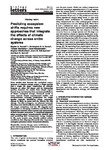Predicting ecosystem shifts requires new approaches that integrate the effects of climate change across entire systems
| dc.contributor.author | Russell, BD | |
| dc.contributor.author | Harley, CDG | |
| dc.contributor.author | Wernberg, T | |
| dc.contributor.author | Mieszkowska, N | |
| dc.contributor.author | Widdicombe, S | |
| dc.contributor.author | Hall-Spencer, Jason | |
| dc.contributor.author | Connell, SD | |
| dc.date.accessioned | 2013-02-20T08:51:12Z | |
| dc.date.available | 2013-02-20T08:51:12Z | |
| dc.date.issued | 2012-04-23 | |
| dc.identifier.issn | 1744-9561 | |
| dc.identifier.issn | 1744-957X | |
| dc.identifier.uri | http://hdl.handle.net/10026.1/1325 | |
| dc.description.abstract |
<jats:p>Most studies that forecast the ecological consequences of climate change target a single species and a single life stage. Depending on climatic impacts on other life stages and on interacting species, however, the results from simple experiments may not translate into accurate predictions of future ecological change. Research needs to move beyond simple experimental studies and environmental envelope projections for single species towards identifying where ecosystem change is likely to occur and the drivers for this change. For this to happen, we advocate research directions that (i) identify the critical species within the target ecosystem, and the life stage(s) most susceptible to changing conditions and (ii) the key interactions between these species and components of their broader ecosystem. A combined approach using macroecology, experimentally derived data and modelling that incorporates energy budgets in life cycle models may identify critical abiotic conditions that disproportionately alter important ecological processes under forecasted climates.</jats:p> | |
| dc.format.extent | 164-166 | |
| dc.format.medium | Print-Electronic | |
| dc.language | en | |
| dc.language.iso | eng | |
| dc.publisher | The Royal Society | |
| dc.subject | climate change | |
| dc.subject | ocean acidification | |
| dc.subject | global warming | |
| dc.subject | species interactions | |
| dc.subject | ecosystem shift | |
| dc.subject | productivity and consumption | |
| dc.title | Predicting ecosystem shifts requires new approaches that integrate the effects of climate change across entire systems | |
| dc.type | journal-article | |
| dc.type | Congress | |
| plymouth.author-url | https://www.webofscience.com/api/gateway?GWVersion=2&SrcApp=PARTNER_APP&SrcAuth=LinksAMR&KeyUT=WOS:000301304000002&DestLinkType=FullRecord&DestApp=ALL_WOS&UsrCustomerID=11bb513d99f797142bcfeffcc58ea008 | |
| plymouth.issue | 2 | |
| plymouth.volume | 8 | |
| plymouth.publication-status | Published | |
| plymouth.journal | Biology Letters | |
| dc.identifier.doi | 10.1098/rsbl.2011.0779 | |
| plymouth.organisational-group | /Plymouth | |
| plymouth.organisational-group | /Plymouth/Faculty of Science and Engineering | |
| plymouth.organisational-group | /Plymouth/Faculty of Science and Engineering/School of Biological and Marine Sciences | |
| plymouth.organisational-group | /Plymouth/PRIMaRE Publications | |
| plymouth.organisational-group | /Plymouth/REF 2021 Researchers by UoA | |
| plymouth.organisational-group | /Plymouth/REF 2021 Researchers by UoA/UoA07 Earth Systems and Environmental Sciences | |
| plymouth.organisational-group | /Plymouth/Research Groups | |
| plymouth.organisational-group | /Plymouth/Research Groups/Marine Institute | |
| plymouth.organisational-group | /Plymouth/Users by role | |
| plymouth.organisational-group | /Plymouth/Users by role/Academics | |
| dc.publisher.place | England | |
| dc.identifier.eissn | 1744-957X | |
| dc.rights.embargoperiod | Not known | |
| rioxxterms.versionofrecord | 10.1098/rsbl.2011.0779 | |
| rioxxterms.licenseref.uri | http://www.rioxx.net/licenses/all-rights-reserved | |
| rioxxterms.type | Journal Article/Review |


